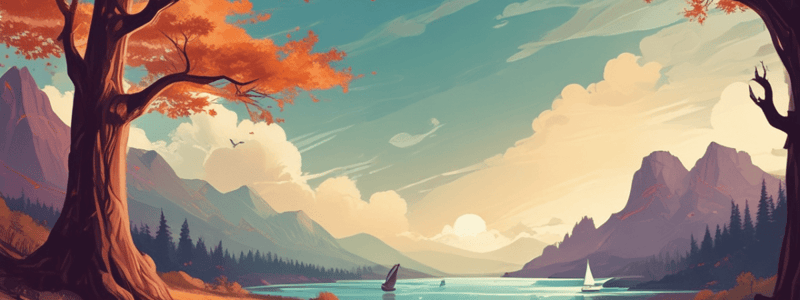Podcast
Questions and Answers
What is the primary composition of comets?
What is the primary composition of comets?
- Ice and nickel
- Clay and iron
- Frozen gases, rock, and dust (correct)
- Rock and metal
What is the region of the Solar System that lies beyond the planets and the orbit of Neptune?
What is the region of the Solar System that lies beyond the planets and the orbit of Neptune?
- Asteroid Belt
- Kuiper Belt (correct)
- Oort Cloud
- Meteoroid Zone
What happens to meteoroids when they enter the Earth's atmosphere?
What happens to meteoroids when they enter the Earth's atmosphere?
- They orbit the Sun
- They become asteroids
- They create a streak of light called a 'falling star' or 'shooting star' (correct)
- They become comets
Where is the Asteroid Belt located in the Solar System?
Where is the Asteroid Belt located in the Solar System?
What is the outer boundary of the Solar System?
What is the outer boundary of the Solar System?
Flashcards are hidden until you start studying
Study Notes
Study Notes
About the Universe
- The universe is made up of thousands of galaxies.
- Galaxies are huge groups of stars held together by gravity.
Solar System
- The Solar System consists of planets, stars, and other objects orbiting the Sun.
- The Sun is a massive, luminous sphere of hot plasma at the center of the Solar System.
- The Sun provides light, heat, and energy to the planets and other objects in orbit around it.
Planets in our Solar System
- Mercury:
- Weighs only 38% of what you weigh on Earth.
- Fastest orbiting planet.
- One side can be 800°F when the other side is -280°F.
- Venus:
- Weighs only 91% of what you weigh on Earth.
- 90 times the pressure of Earth.
- Rotates in the opposite direction of Earth.
- Earth:
- 23 hours and 56 minutes = 1 Earth day (rotation).
- 365 days = 1 Earth year (revolution).
- Warm enough to keep most water from freezing and cold enough to keep water from boiling.
- Mars:
- Air pressure is the same as 30 km above the Earth's surface.
- Evidence of water existing in the past.
- Volcanic history like Earth.
- Tallest mountain (Olympus Mons) is 3x the size of Mt. Everest.
Outer Planets (Gas Planets or Jovian Planets)
- Jupiter:
- Largest planet in the Solar System.
- Great Red Spot from a storm system larger than Earth.
- Pressure is so great it would crush a spaceship.
- Saturn:
- 2nd largest planet in the Solar System.
- 95 times more massive than Earth.
- Largest rings of any planet, made of icy particles.
- Most moons of any planet.
- Uranus:
- Appears blue-green in color.
- Axis of rotation is tilted 90 degrees.
- Moons are named after Shakespearean plays and formed from broken moons.
- Neptune:
- Discovered in 1846.
- Visual belts of clouds.
- Interior releases thermal energy to outer layers.
Comets, Asteroids, and Meteoroids
- Comets:
- Cosmic snowballs of frozen gases, rock, and dust orbiting the Sun.
- When close to the Sun, comets heat up and spew dust and gases into a giant glowing head and tail.
- Asteroids:
- Small, rocky objects orbiting the Sun.
- Found in the orbital path of the planets.
- Made up of clays and metals like nickel and iron.
- Asteroid Belt:
- Region between Mars and Jupiter where most asteroids orbit the Sun.
- Kuiper Belt:
- Region beyond the planets and the orbit of Neptune.
- Contains millions of icy objects, including dwarf planets Pluto and Eris.
- Oort Cloud:
- Region beyond the Kuiper Belt containing billions of comets.
- The outer limit of the Oort Cloud defines the outer boundary of the Solar System.
- Meteoroids:
- Small pieces of rock or metal broken off from comets and asteroids.
- When pulled into the Earth's atmosphere by gravity, they become meteors.
- When meteors hit the atmosphere, they create a streak of light called a "falling star" or "shooting star".
Studying That Suits You
Use AI to generate personalized quizzes and flashcards to suit your learning preferences.



